The perfect pout requires patience and guidance on the best aftercare practices. Lip blush tattooing is a permanent makeup treatment that deposits coloured ink into the lips with a single mechanical needle through a quick hand motion and dotting technique.
While lip blushing lasts around 2-3 years between treatments, the aftercare protocols and best practices are similar to those of a permanent tattoo. The early healing stage lasts for 10-14 days and your lips should fully heal in around 4 weeks.
As with any tattooing procedure, your aftercare routine largely determines how your lips will look in the long term. Learning the best hygiene practices and necessary lifestyle modifications will ensure you end up with a properly shaded, smooth and healthy pout. Here’s everything to expect during the lip blush tattoo healing process for the best, lasting results.
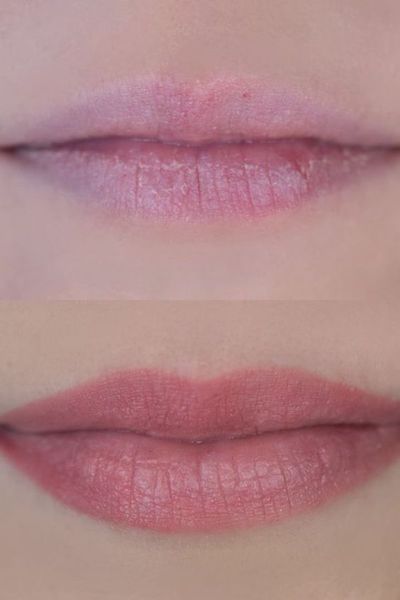
Credit: Popsugar/Pinterest
The First 24 Hours
Expect your lips to be fairly swollen for the first day or so after the lip blushing treatment. Most levels of mild to moderate swelling are normal. A patch test should always be done at least 24 hours before your appointment to ensure that you aren’t allergic to the ink.
Your permanent makeup artist will likely use a numbing cream, like Numbing Cream, to ensure that you do not feel pain during the procedure. As the numbing sensation starts to fade, you might experience some tenderness and soreness in the area. These side effects can be reduced by applying ice packs wrapped in fresh towels to your lips.
The lip tattooing creates tiny wounds that provoke your body’s inflammatory response. As a result, your lips will begin to produce lymphatic fluid right after your session finishes. Use a clean water wipe to wash off this fluid from your lips around 4-6 hours after the procedure.
Follow this step with a moisturizing balm, like Healing Cream. Keep the area clean and hydrated.
Like with permanent tattoos, your lip blushing colour will be most vibrant immediately following your session. The colour will start to fade to the hue you initially selected during your consultation as these micro-wounds start to repair themselves.
Next Day(s) Expectations
The swelling should go down around 2 days after your lip blushing tattoo treatment. By the 3-day mark, the lip blush hue should get a bit darker than it was right after the procedure. During this time, it is crucial to continue cleansing and moisturizing the area twice a day. Wash your lips with water or a fragrance-free cleanser on a cotton pad before hydrating the area with occlusive balm or gentle moisturizer (Otsuji recommends Aquaphor Healing Ointment or Healing Cream, according to her commentary for Byrdie).
Hydrate your lips as often as needed to keep the dryness at bay (without overdoing it).
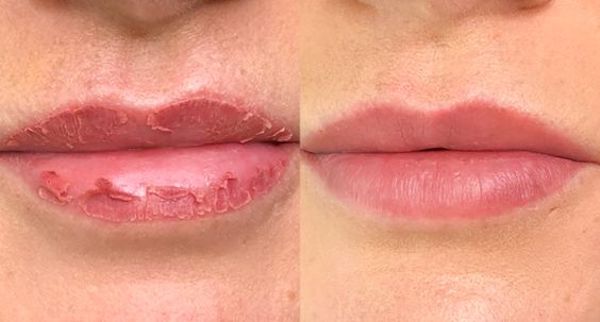
Credit: Tina Davies Professional/Pinterest
The Flaky Stage
Your lips will start to flake and peel around 3-4 days after your lip blushing session. During this stage, scabs begin to form to recover from the needle-induced wounds. This portion of the healing process is nearly identical to that of a traditional tattoo. Never peel off the scabs – no matter how tempting this idea may be. Picking off the skin can fade the lip blush’s pigment or patchiness throughout the area. Like other scabs, this activity can also reopen the wound, leaving you more susceptible to infections. Let these dry flakes fall off naturally as a new layer of healed skin comes through underneath. Make sure to stay consistent with your washing and lip hygiene routine. Keeping your lips hydrated is vital at this stage.
The peeling stage can last up to a week and it may take the ink up to four weeks to fully settle into the skin.

Credit: The Baller on A Budget/Pinterest
Final Healing Days
Once the flakiness starts to subside (around 5-6 days after the treatment), the colour on your nearly-healed lips will likely be 30 to 50 percent lighter than they were when you got up from the studio chair. Don’t worry if the pigment “disappears” for a period before returning a couple of weeks later. This outcome is normal during the end of the recovery process. The skin thickens as it heals and briefly conceals the ink. Once the skin repairs itself (after around 4-6 weeks) and the colour settles, the ink will become visible again and “return” to your ideal lip pigment shade.
Around 8 weeks after your initial lip blushing treatment, schedule a follow-up appointment with your technician. During this short session, necessary touch-ups can be made – whether you need to even out, neutralize or lighten your lip shade.
Long-Term After-care
Apply a lip balm with SPF before going outside to shield the skin from the sun and keep the pigment from fading. This practice can also help avoid your lips from developing fine lines and wrinkles, which will be even more apparent with lip blushing. While permitted after healing, regular exfoliation can cause your lip blushing tattoo to fade more quickly.
Smoking, oil-prone skin or having an iron deficiency can also negatively impact the treatment’s longevity.
What To Avoid During The After-care Process
While it’s easier said than done, you shouldn’t touch your lips unless you’re cleaning or moisturizing the area. Always use a cotton pad, clean towel or washed hands when applying these hygiene products.
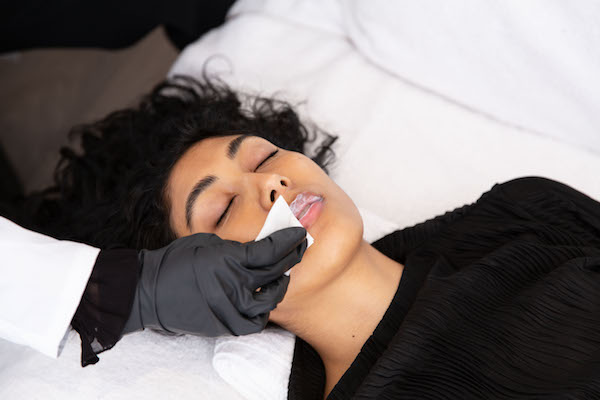
During the healing process, you should refrain from activities or using products that could irritate your lips. Like any other tattoo, lip blushing leaves open wounds throughout the area that are vulnerable to infection. Intense exercise, swimming, saunas and any sweat-inducing practice should be avoided for at least two weeks after lip blushing. The excess moisture and sweat particles leave your skin susceptible to germs that could host a bacterial or fungal infection.
Skip the spicy food, soups and hot beverages for at least 48 hours after your treatment. Only drink through a straw and try to place foods directly in your mouth with a fork if you can. Stay away from acidic, oily or salty foods and alcohol during the healing process if possible, too.
Don’t use white strips on your teeth while your lips are recovering. When brushing your teeth, you should make sure not to get toothpaste on the treated area.
Stay away from direct sun exposure, chemical peels or laser treatments for at least two weeks after lip blushing.
Avoid kissing, skin friction, wearing lipstick or lipgloss and lip exfoliators during the healing process as well.
Lip Blushing Quick Facts
Each lip blush tattoo treatment costs between $500-$1,500. While your local area, artist and cosmetic studio selection contribute to the price, keep in mind that a pigmented pout costs a pretty penny.
The entire session should take approximately 60-90 minutes between the initial consultation (to discuss desired results and shade selection) and the permanent makeup procedure. The follow-up appointment should be significantly shorter. Lip blushing tattoos last on average between two to three years without touch-ups.
Ensure that your artist has the licenses and certifications required in your area to perform permanent makeup services. These common licenses include an esthetician’s license and a blood-borne pathogen certificate. Make sure to also thoroughly research your prospective artist online via social media, Yelp, Google reviews, etc. Come prepared for your consultations and ask informed questions to ensure this artist and their work is the right fit for your desired results.
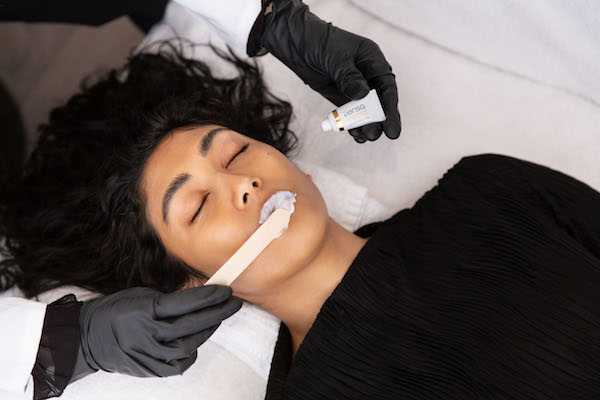
Does Lip Blushing Hurt?
The lips are a naturally sensitive area, so worrying about the pain is an understandable concern. Fortunately, experts frequently apply a topical numbing cream to reduce the pain level significantly. The numbing cream is left on for approximately 20 minutes before the procedure begins.
Many artists now seek to provide lip blushing experiences with fully natural products – like Numbing Cream. It features 5% lidocaine for maximum strength, has a natural PH formulation to cater to sensitive areas, including the lips, and does not contain any vasoconstrictors that prevent the ink from properly settling.
Who Doesn’t Qualify For Lip Blushing?
Those currently on blood-thinning medications or suffering from chronic cold sores or lip dryness typically do not qualify for lip blushing treatments. These conditions often indicate a weaker immune system and can make you more vulnerable to getting an infection from the procedure. Chapped lips can also be caused by seasonal factors, such as harsh winter temperatures or prolonged sun exposure during the warmer months. In this case, it is best to wait out the weather and allow your lips to rehydrate before booking an appointment.
Women who are pregnant or nursing must avoid lip blushing and any other permanent makeup treatments. The risk for infections is even greater during these times and hormone changes could affect how the pigment shows up on your skin.

 English
English

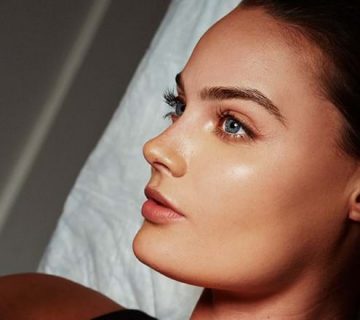
No comment